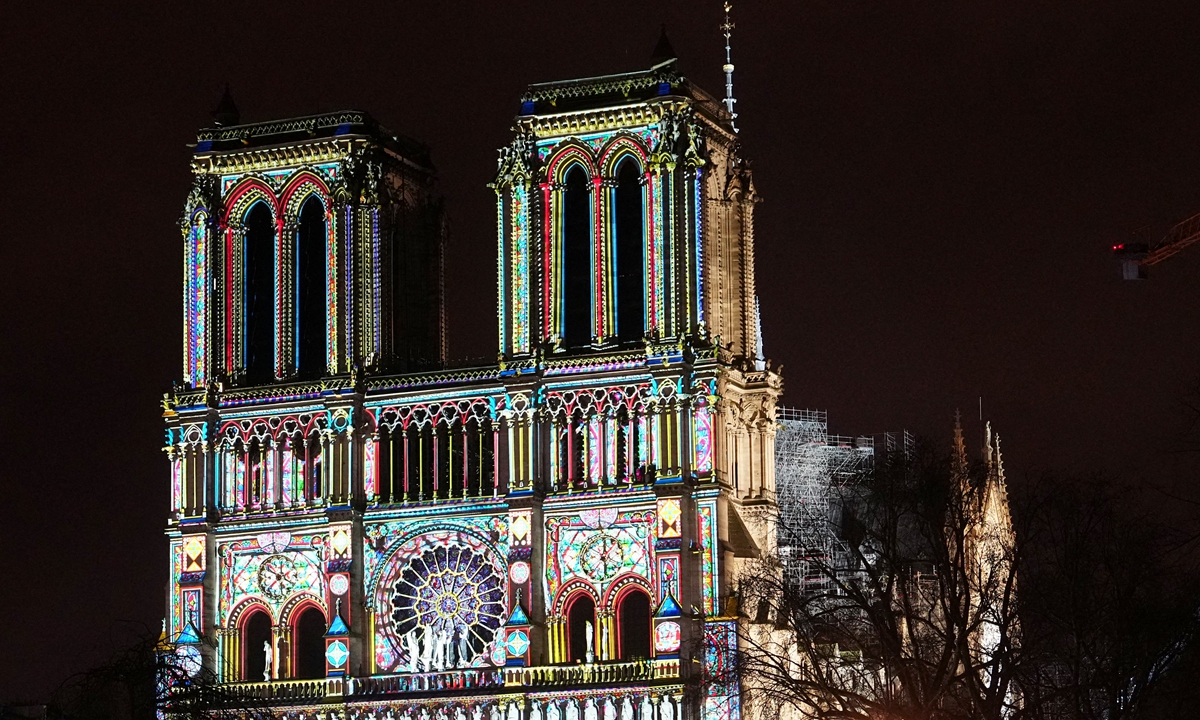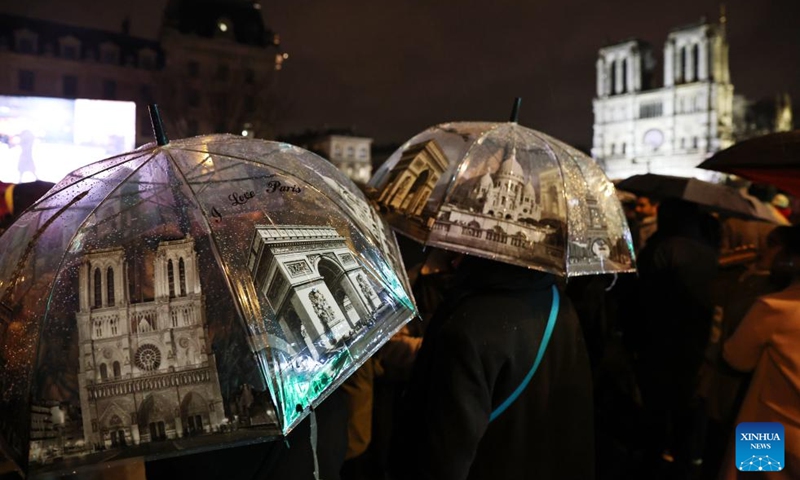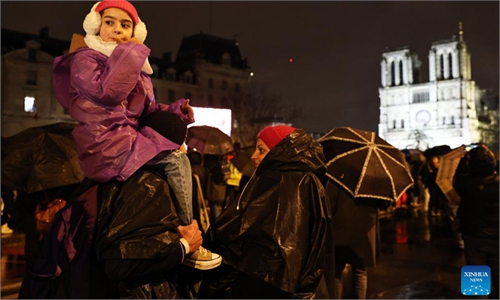ARTS / CULTURE & LEISURE
Notre-Dame de Paris reopens with China's significant role in restoration

Crowds stand outside Notre-Dame de Paris cathedral as it is illuminated during a ceremony to mark the reopening of the landmark cathedral, in central Paris, on December 7, 2024. Photo: AFP
The restored Notre-Dame de Paris cathedral in Paris officially reopened on Saturday with a grand inauguration ceremony after being devastated by a fire five years ago. The news has grabbed Chinese people's attention as specialists from China's Emperor Qinshihuang's Mausoleum Site Museum also assisted with restoration.The ceremony began with a tribute film, honoring all those who have played a role in the rescue and restoration of Notre-Dame. "Thank You" was projected in multiple languages on the cathedral's iconic facade.
US President-elect Donald Trump, US First Lady Jill Biden and Britain's Prince William were among the 1,500 guests attending the reopening celebration.
French President Emmanuel Macron, speaking at the event, expressed France's deep gratitude to "all those who saved, helped, and rebuilt Notre-Dame de Paris," and to those present to witness the return of the cathedral "to Paris, to France, and to the whole world," according to Xinhua News Agency.
Macron emphasized the significance of the restoration, saying, "We have chosen the surge, the will, the course of hope," with the aim of making Notre-Dame even more beautiful.
Chinese pianist Lang Lang was invited to participate in the opening concert, where he, along with many other artists, presented a grand musical feast for this globally anticipated moment.
"The historic concert reopening of Notre Dame in Paris is happening tonight, and I'm so honored to perform alongside some amazing artists!" Lang Lang said on his social media account.
Following the catastrophic fire on April 15, 2019, China was the first country to sign an intergovernmental agreement with France for the restoration of the cathedral, enabling Chinese experts to contribute to the restoration project.
According to CCTV News, the five-year restoration involved more than 2,000 craftsmen and experts, with a total cost of nearly 700 million euros. It is reported that after the reopening of the cathedral, it is expected to welcome 14 to 15 million visitors each year.
In February 2024, Emperor Qinshihuang's Mausoleum Site Museum in Northwest China's Shaanxi Province sent specialists to Paris to assist with the conservation and restoration of Notre-Dame. China and France have jointly initiated scientific research on the preservation of wooden relics and earthen sites from both Notre-Dame and the Mausoleum of Emperor Qinshihuang.
Zhou Ping, a deputy director of the Chinese museum, told Phoenix TV that Chinese experts were the first non-French professional team to ascend the spire of Notre-Dame.
In February 2023, Zhou was appointed to participate in the cathedral's restoration. During the restoration, she contributed China's expertise in cultural relic preservation, including marble cleaning, research on charred wood, and conservation techniques for murals, metals and related artifacts.
The construction of Notre-Dame utilized traditional French roofing techniques, with a layer of lead covering the entire roof. However, lead has a relatively low melting point, and under the high temperatures of the fire, it melted and combined with dust to form lead-containing dust, which spread widely across Paris and its surrounding areas, Zhou said. Monitoring has shown that even over 60 kilometers away from the city of Paris, lead dust generated by the Notre-Dame fire can still be detected.
Zhou stated that during the maintenance process, the repair team placed great importance on the removal of lead dust, integrating this work throughout the entire implementation of the project. This not only meets the needs of the engineering project itself but also reflects a humanitarian concern for the workers, the surrounding buildings of the cathedral, and the residents of the related areas.
Zhou noted that both Notre-Dame and the Terracotta Army of Emperor Qinshihuang extensively used wooden materials, both of which have charred remains. By studying these burned wood or charcoal relics, the Chinese and French teams advanced research that connects the two cultural relics together.
The restoration of the Notre-Dame de Paris is a significant cultural event, and in this context, China and France are collaborating primarily to discuss the preservation of wooden relics. How to preserve this world cultural heritage is a key focus, Chen Jiachang from the China Academy of Cultural Heritage told the Global Times on Sunday.
"The protection of cultural relics, especially restoration, is not merely about renovation; it is more about how to handle the many wooden structures of the cathedral. The aim is to showcase the old materials and damaged wooden components in a way that serves as a warning for future generations," Chen said.

People gather outside the restored Notre-Dame de Paris cathedral in the rain in Paris, France, Dec. 7, 2024. Five years after being devastated by a fire, the restored Notre-Dame de Paris cathedral officially reopened on Saturday with a grand inauguration ceremony attended by world leaders, believers, and non-believers alike. Photo: Xinhua


